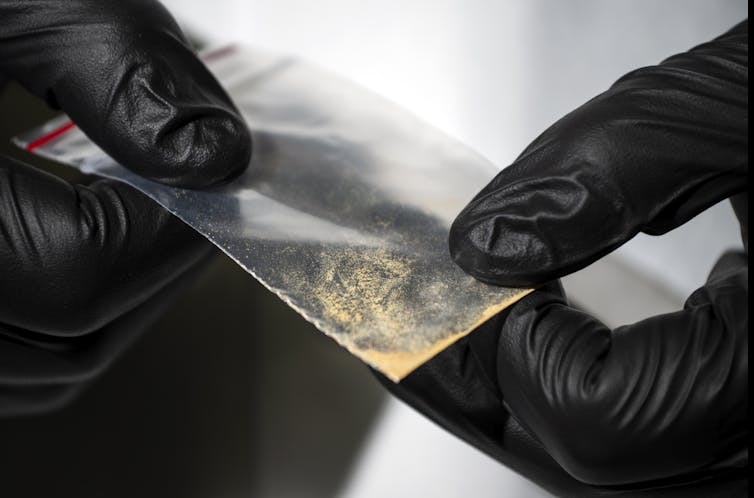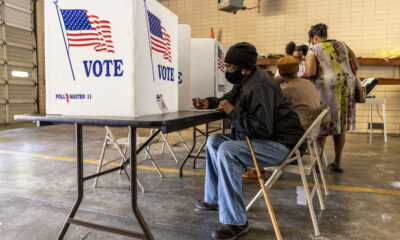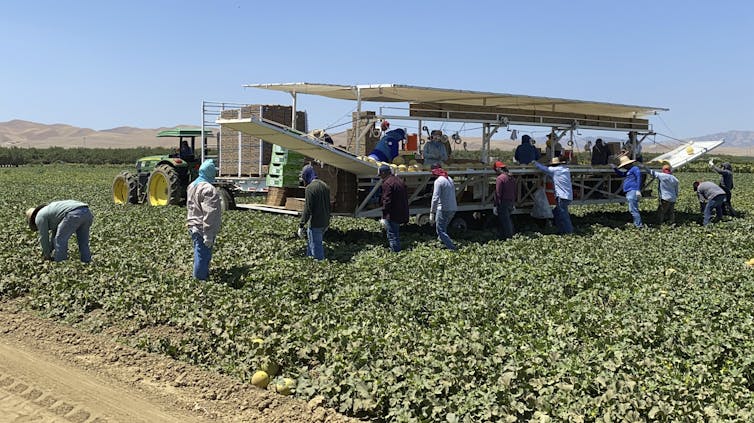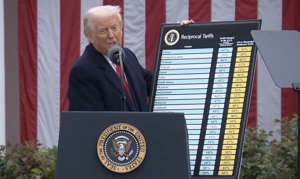
Juan Pablo Pino/AFP via Getty Images
Karli Hochstatter, Columbia University and Fernando Montero, Columbia University
As much as half of the fentanyl sold on Philly’s streets contains an industrial chemical used in plastics manufacturing. That’s according to our November 2024 testing of fentanyl samples collected in Philadelphia’s Kensington neighborhood, regarded as the largest open-air drug market on the East Coast.
What’s more, the amount, or concentration, of this industrial chemical in the drug samples often exceeded the amount of fentanyl.
We are an epidemiologist and anthropologist whose research focuses on substance use disorders and the opioid overdose epidemic. Our team’s findings were published in the peer-reviewed Journal of the American Medical Association in February 2025.
The industrial chemical we found is called BTMPS, which is the common abbreviation for bis(2,2,6,6-tetramethyl-4-piperidyl) sebacate. BTMPS belongs to a class of molecules called hindered amine light stabilizers that manufacturers frequently add to plastics and other polymers to protect against degradation from heat and sunlight.
Since March 2024, our team has tested 228 street fentanyl samples collected in Kensington. Of these, 39 – or 17% – contained BTMPS.
We first detected BTMPS in Philadelphia in June 2024. We found it in two of the eight samples – 25% – that we collected that month. By November 2024, 12 of 22 samples – or 55% – contained BTMPS.
Why BTMPS is being added to the street opioid supply, and at what stage in production or distribution it is being added, remains unknown.
Researchers suspect that it may be added to stabilize a fentanyl precursor chemical that is susceptible to degradation from heat and oxygen.
Given its low cost, BTMPS may also be added to dilute other psychoactive substances or more expensive ingredients or both.

Spencer Platt via Getty Images
How toxic is BTMPS?
Among the 39 samples that contained BTMPS in Philadelphia, the average amount of BTMPS was nearly double that of fentanyl. On average, BTMPS made up 4% of the sample, while fentanyl made up 2.3% of the sample. In one sample tested, BTMPS made up 18% of the sample.
BTMPS has not been approved for human consumption or been studied in humans.
However, it has been shown in rat studies to reduce nicotine use and attenuate withdrawal symptoms associated with morphine and cocaine.
The rat studies revealed several adverse health effects from exposure to BTMPS. They include heart defects, serious eye damage and death.
These findings raise concerns about the increasing exposure of BTMPS to humans through street drugs. The concentrations up to 18% found in the Philly samples are many orders of magnitude higher than the estimated concentration of 0.1% to 0.5% that people are exposed to through plastic products.

Joe Lamberti for The Washington Post via Getty Images
BTMPS appearing in fentanyl across the US
Our colleagues who are testing street opioid samples in other regions also detected BTMPS in fentanyl samples or paraphernalia residue in Delaware, Maryland, Nevada, Washington and California. In Los Angeles, BTMPS was first detected in July 2024 – by September, 56% of samples there contained it.
The sudden and almost simultaneous appearance of a new adulterant in U.S. street opioids from the East Coast to the West Coast is rare. For example, fentanyl, xylazine and medetomidine became prevalent in the U.S. opioid supply in different regions at different times.
The recent emergence of BTMPS in street opioid markets nationwide suggests that it may be entering the supply at an early stage in production or wholesale distribution.
Historically, Philadelphia’s street opioid supply has had strong ties to Puerto Rico. These ties influenced Philly’s early incorporation of the veterinary sedative xylazine into the street drug supply. Since 2021, xylazine has been present in virtually all of Philly’s street fentanyl.
Given these associations, we are also testing the street opioid supply in Puerto Rico to examine potential similarities and relationships with Philadelphia’s supply. To date, we have detected BTMPS in two out of 49 – or 4% – of street opioid samples in Puerto Rico. We first detected it in a sample in September 2024 and again in December 2024.
What’s next
We continue to monitor BTMPS trends in Philadelphia’s street fentanyl. We are also examining whether concentrations of fentanyl and other key compounds such as xylazine in Philly’s street fentanyl have changed as new adulterants such as BTMPS and medetomidine become more widespread – and whether these changes play a role in the declining overdose death rate in Pennsylvania and other parts of the U.S.
We are also developing plans to study the immediate and long-term effects that BTMPS exposure has on people using drugs.![]()
Karli Hochstatter, Research Scientist in Epidemiology and Health Services, Columbia University and Fernando Montero, Postdoctoral Research Fellow in Psychiatry and Social Work, Columbia University
This article is republished from The Conversation under a Creative Commons license. Read the original article.




















































